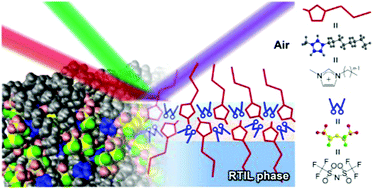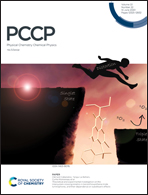Bi-layering at ionic liquid surfaces: a sum-frequency generation vibrational spectroscopy- and molecular dynamics simulation-based study†
Abstract
Room-temperature ionic liquids (RTILs) are being increasingly employed as novel solvents in several fields, including chemical engineering, electrochemistry, and synthetic chemistry. To further increase their usage potential, a better understanding of the structure of their surface layer is essential. Bi-layering at the surfaces of RTILs consisting of 1-alkyl-3-methylimidazolium ([Cnmim]+; n = 4, 6, 8, 10, and 12) cations and bis(trifluoromethanesulfonyl)amide ([TFSA]−) anions was demonstrated via infrared-visible sum-frequency generation (IV-SFG) vibrational spectroscopy and molecular dynamics (MD) simulations. It was found that the sum-frequency (SF) signal from the [TFSA]− anions decreases as the alkyl chain length increases, whereas the SF signal from the r+ mode (the terminal CH3 group) of the [Cnmim]+ cations is almost the same regardless of chain length. MD simulations show the formation of a bi-layered structure consisting of the outermost first layer and a submerged second layer in a “head-to-head” molecular arrangement. The decrease in the SF signals of the normal modes of the [TFSA]− anions is caused by destructive and out-of-phase interference of vibrations of corresponding molecular moieties oriented toward each other in the first and second layers. In contrast, the r+ mode of [Cnmim]+ does not experience destructive interference because the peak position of the r+ mode differs marginally at the surface and in the bulk. Our conclusions are not limited to the system presented here. Similar bi-layered structures can be expected for the surfaces of conventional RTILs, which necessitates the consideration of bi-layering in the design and application.



 Please wait while we load your content...
Please wait while we load your content...